Acura ILX 2014 Owner's Manual
Manufacturer: ACURA, Model Year: 2014, Model line: ILX, Model: Acura ILX 2014Pages: 351, PDF Size: 7.94 MB
Page 331 of 351
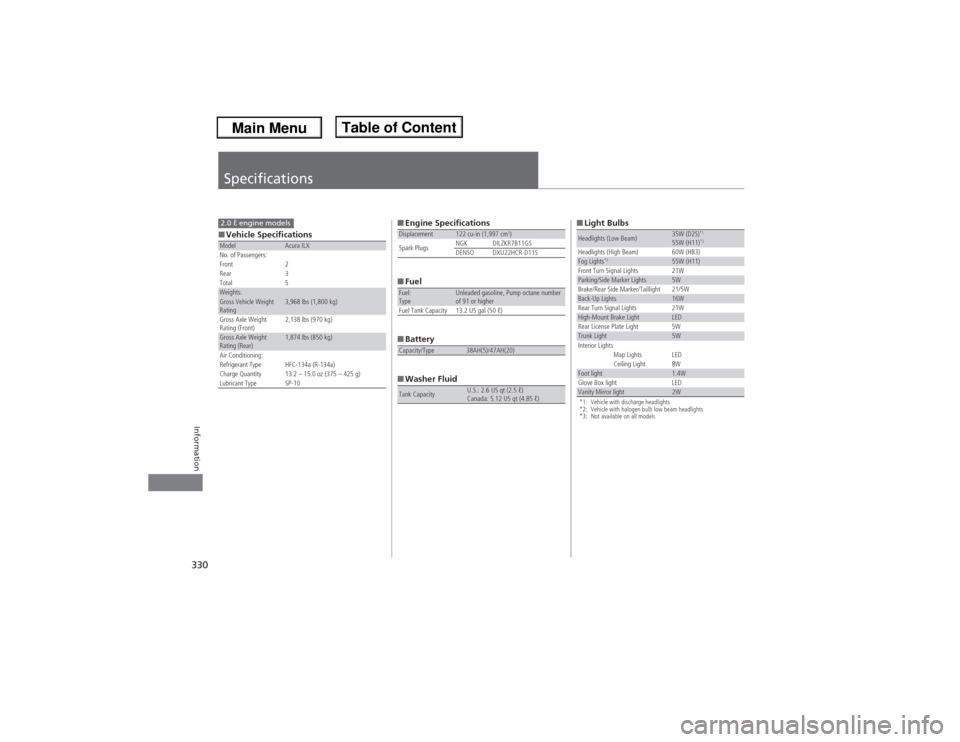
330Information
Specifications■Vehicle SpecificationsModel
Acura ILX
No. of Passengers:
Front 2
Rear 3
Total 5
Weights:Gross Vehicle Weight
Rating
3,968 lbs (1,800 kg)
Gross Axle Weight
Rating (Front)
2,138 lbs (970 kg)
Gross Axle Weight
Rating (Rear)
1,874 lbs (850 kg)
Air Conditioning:
Refrigerant Type HFC-134a (R-134a)
Charge Quantity 13.2 – 15.0 oz (375 – 425 g)
Lubricant Type SP-10
2.0 ℓ engine models
■Engine Specifications
■Fuel
■Battery
■Washer FluidDisplacement
122 cu-in (1,997 cm
3)
Spark PlugsNGK DILZKR7B11GS
DENSO DXU22HCR-D11S
Fuel:
Type
Unleaded gasoline, Pump octane number
of 91 or higher
Fuel Tank Capacity 13.2 US gal (50 ℓ)
Capacity/Type
38AH(5)/47AH(20)
Tank Capacity
U.S.: 2.6 US qt (2.5 ℓ)
Canada: 5.12 US qt (4.85 ℓ)
■Light Bulbs*1: Vehicle with discharge headlights
*2: Vehicle with halogen bulb low beam headlights
*3: Not available on all modelsHeadlights (Low Beam)
35W (D2S)
*1
55W (H11)
*2
Headlights (High Beam) 60W (HB3)Fog Lights
*3
55W (H11)
Front Turn Signal Lights 21W
Parking/Side Marker Lights
5W
Brake/Rear Side Marker/Taillight 21/5W
Back-Up Lights
16W
Rear Turn Signal Lights 21W
High-Mount Brake Light
LED
Rear License Plate Light 5W
Trunk Light
5W
Interior Lights
Map Lights LED
Ceiling Light 8W
Foot light
1.4W
Glove Box light LED
Vanity Mirror light
2W
Page 332 of 351
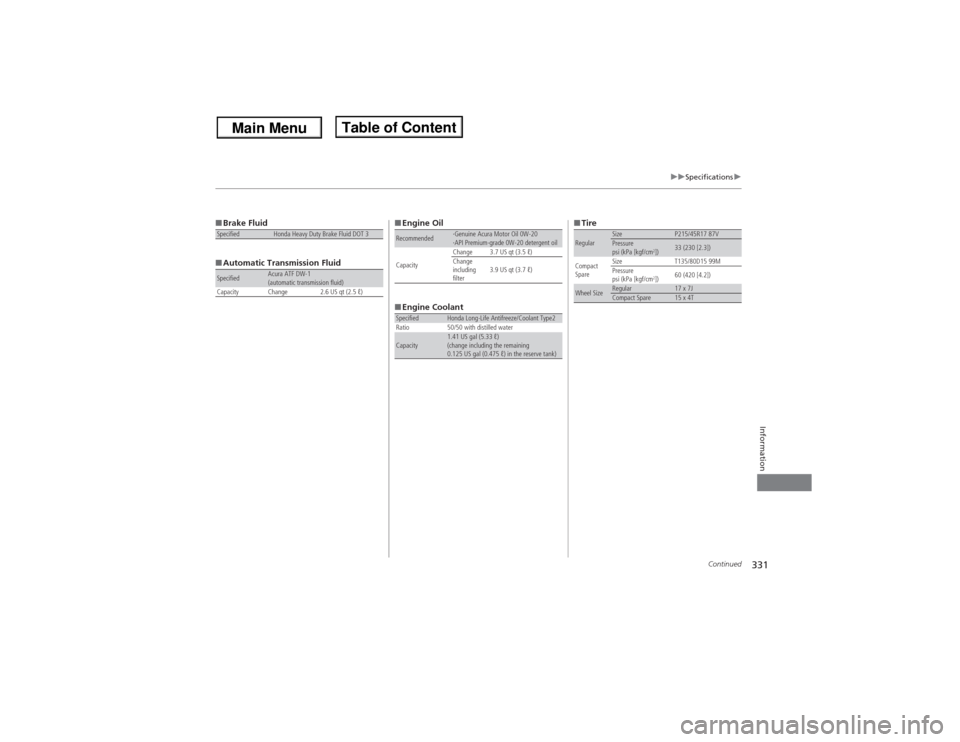
331
uuSpecificationsu
Continued
Information
■Brake Fluid
■Automatic Transmission FluidSpecified
Honda Heavy Duty Brake Fluid DOT 3
Specified
Acura ATF DW-1
(automatic transmission fluid)
Capacity Change 2.6 US qt (2.5 ℓ)
■Engine Oil
■Engine CoolantRecommended
·Genuine Acura Motor Oil 0W-20
·API Premium-grade 0W-20 detergent oil
CapacityChange 3.7 US qt (3.5 ℓ)
Change
including
filter3.9 US qt (3.7 ℓ)
Specified
Honda Long-Life Antifreeze/Coolant Type2
Ratio 50/50 with distilled water
Capacity
1.41 US gal (5.33 ℓ)
(change including the remaining
0.125 US gal (0.475 ℓ) in the reserve tank)
■TireRegular
Size
P215/45R17 87V
Pressure
psi (kPa [kgf/cm
2])
33 (230 [2.3])
Compact
SpareSize T135/80D15 99M
Pressure
psi (kPa [kgf/cm
2])60 (420 [4.2])
Wheel Size
Regular
17 x 7J
Compact Spare
15 x 4T
Page 333 of 351
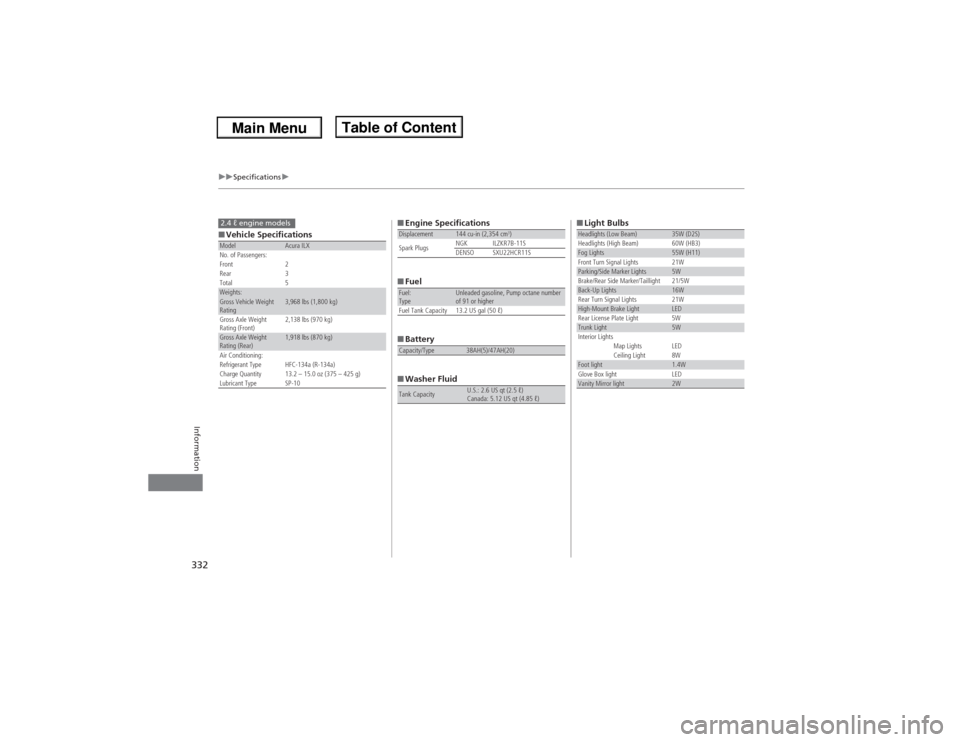
332
uuSpecificationsu
Information
■Vehicle SpecificationsModel
Acura ILX
No. of Passengers:
Front 2
Rear 3
Total 5
Weights:Gross Vehicle Weight
Rating
3,968 lbs (1,800 kg)
Gross Axle Weight
Rating (Front)
2,138 lbs (970 kg)
Gross Axle Weight
Rating (Rear)
1,918 lbs (870 kg)
Air Conditioning:
Refrigerant Type HFC-134a (R-134a)
Charge Quantity 13.2 – 15.0 oz (375 – 425 g)
Lubricant Type SP-10
2.4 ℓ engine models
■Engine Specifications
■Fuel
■Battery
■Washer FluidDisplacement
144 cu-in (2,354 cm
3)
Spark PlugsNGK ILZKR7B-11S
DENSO SXU22HCR11S
Fuel:
Type
Unleaded gasoline, Pump octane number
of 91 or higher
Fuel Tank Capacity 13.2 US gal (50 ℓ)
Capacity/Type
38AH(5)/47AH(20)
Tank Capacity
U.S.: 2.6 US qt (2.5 ℓ)
Canada: 5.12 US qt (4.85 ℓ)
■Light BulbsHeadlights (Low Beam)
35W (D2S)
Headlights (High Beam) 60W (HB3)
Fog Lights
55W (H11)
Front Turn Signal Lights 21W
Parking/Side Marker Lights
5W
Brake/Rear Side Marker/Taillight 21/5W
Back-Up Lights
16W
Rear Turn Signal Lights 21W
High-Mount Brake Light
LED
Rear License Plate Light 5W
Trunk Light
5W
Interior Lights
Map Lights LED
Ceiling Light 8W
Foot light
1.4W
Glove Box light LED
Vanity Mirror light
2W
Page 334 of 351
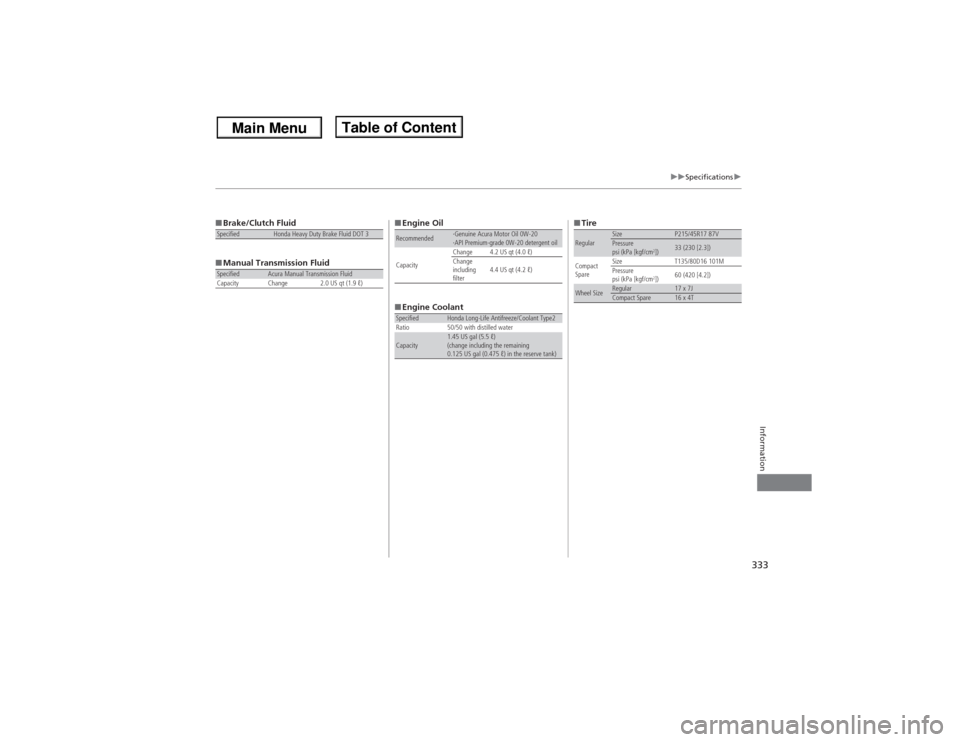
333
uuSpecificationsu
Information
■Brake/Clutch Fluid
■Manual Transmission FluidSpecified
Honda Heavy Duty Brake Fluid DOT 3
Specified
Acura Manual Transmission Fluid
Capacity Change 2.0 US qt (1.9 ℓ)
■Engine Oil
■Engine CoolantRecommended
·Genuine Acura Motor Oil 0W-20
·API Premium-grade 0W-20 detergent oil
CapacityChange 4.2 US qt (4.0 ℓ)
Change
including
filter4.4 US qt (4.2 ℓ)
Specified
Honda Long-Life Antifreeze/Coolant Type2
Ratio 50/50 with distilled water
Capacity
1.45 US gal (5.5 ℓ)
(change including the remaining
0.125 US gal (0.475 ℓ) in the reserve tank)
■TireRegular
Size
P215/45R17 87V
Pressure
psi (kPa [kgf/cm
2])
33 (230 [2.3])
Compact
SpareSize T135/80D16 101M
Pressure
psi (kPa [kgf/cm
2])60 (420 [4.2])
Wheel Size
Regular
17 x 7J
Compact Spare
16 x 4T
Page 335 of 351
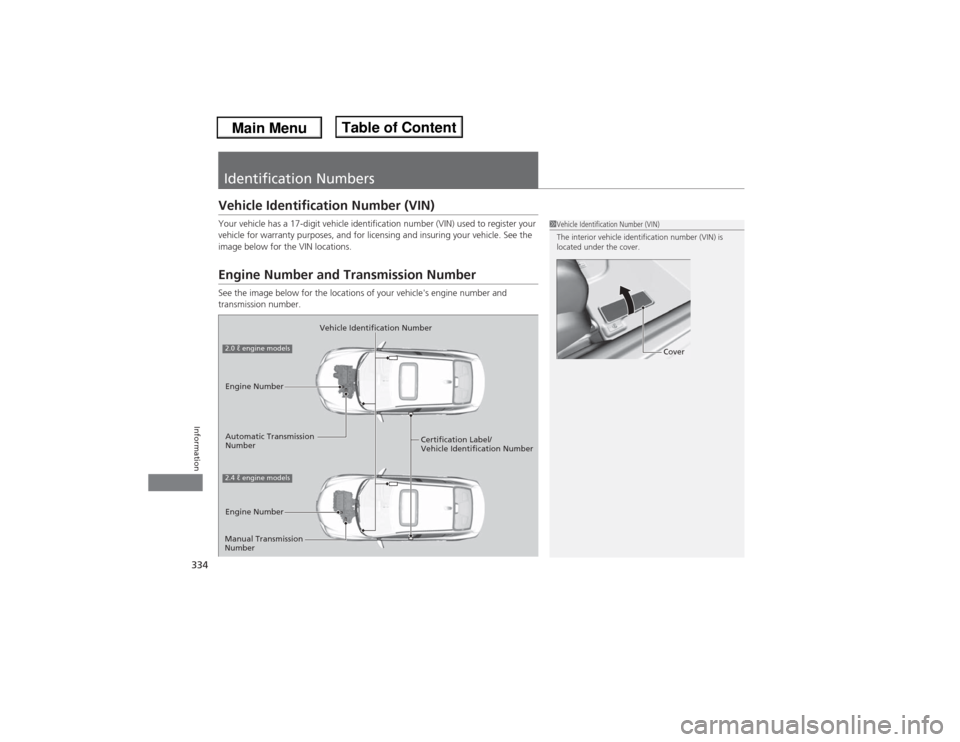
334Information
Identification NumbersVehicle Identification Number (VIN)Your vehicle has a 17-digit vehicle identification number (VIN) used to register your
vehicle for warranty purposes, and for licensing and insuring your vehicle. See the
image below for the VIN locations.Engine Number and Transmission NumberSee the image below for the locations of your vehicle's engine number and
transmission number.
1Vehicle Identification Number (VIN)
The interior vehicle identification number (VIN) is
located under the cover.
Cover
Vehicle Identification Number
Engine Number
Automatic Transmission
Number
Engine Number
2.0 ℓ engine models2.4 ℓ engine models
Certification Label/
Vehicle Identification Number
Manual Transmission
Number
Page 336 of 351
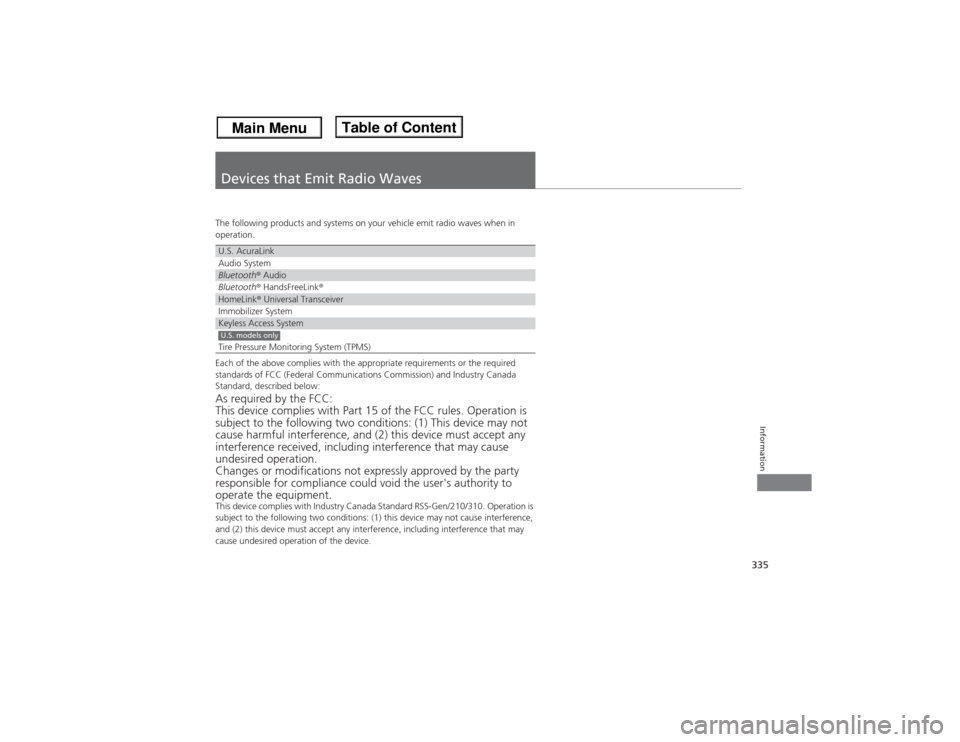
335Information
Devices that Emit Radio WavesThe following products and systems on your vehicle emit radio waves when in
operation.
Each of the above complies with the appropriate requirements or the required
standards of FCC (Federal Communications Commission) and Industry Canada
Standard, described below:As required by the FCC:
This device complies with Part 15 of the FCC rules. Operation is
subject to the following two conditions: (1) This device may not
cause harmful interference, and (2) this device must accept any
interference received, including interference that may cause
undesired operation.
Changes or modifications not expressly approved by the party
responsible for compliance could void the user's authority to
operate the equipment.This device complies with Industry Canada Standard RSS-Gen/210/310. Operation is
subject to the following two conditions: (1) this device may not cause interference,
and (2) this device must accept any interference, including interference that may
cause undesired operation of the device.U.S. AcuraLinkAudio SystemBluetooth® AudioBluetooth® HandsFreeLink®HomeLink® Universal TransceiverImmobilizer SystemKeyless Access SystemTire Pressure Monitoring System (TPMS)U.S. models only
Page 337 of 351
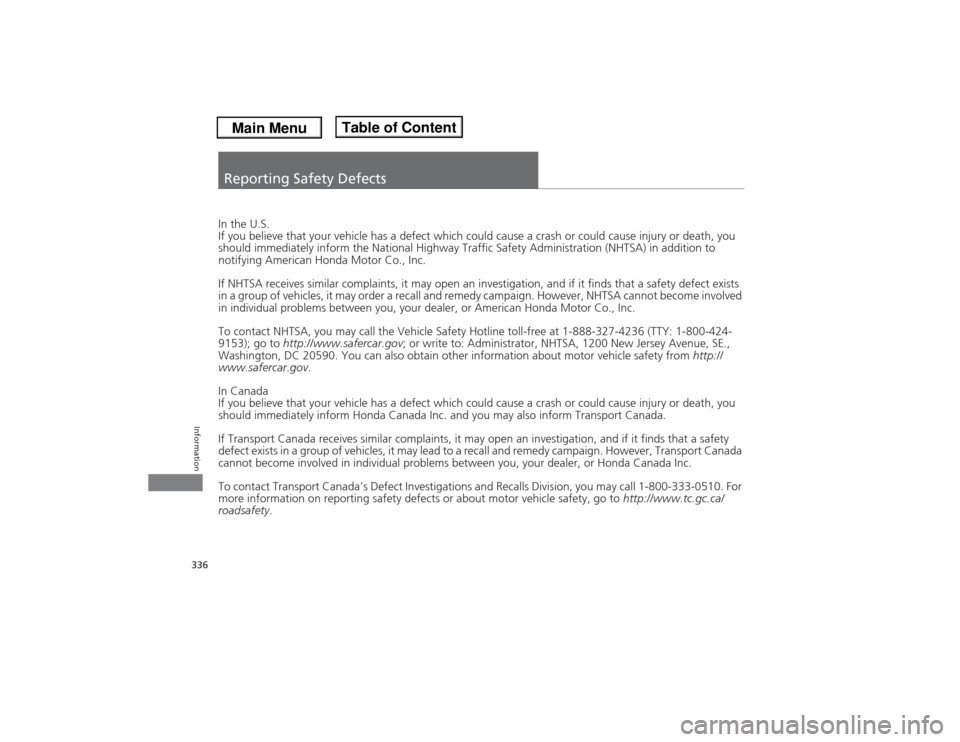
336Information
Reporting Safety DefectsIn the U.S.
If you believe that your vehicle has a defect which could cause a crash or could cause injury or death, you
should immediately inform the National Highway Traffic Safety Administration (NHTSA) in addition to
notifying American Honda Motor Co., Inc.
If NHTSA receives similar complaints, it may open an investigation, and if it finds that a safety defect exists
in a group of vehicles, it may order a recall and remedy campaign. However, NHTSA cannot become involved
in individual problems between you, your dealer, or American Honda Motor Co., Inc.
To contact NHTSA, you may call the Vehicle Safety Hotline toll-free at 1-888-327-4236 (TTY: 1-800-424-
9153); go to http://www.safercar.gov; or write to: Administrator, NHTSA, 1200 New Jersey Avenue, SE.,
Washington, DC 20590. You can also obtain other information about motor vehicle safety from http://
www.safercar.gov.
In Canada
If you believe that your vehicle has a defect which could cause a crash or could cause injury or death, you
should immediately inform Honda Canada Inc. and you may also inform Transport Canada.
If Transport Canada receives similar complaints, it may open an investigation, and if it finds that a safety
defect exists in a group of vehicles, it may lead to a recall and remedy campaign. However, Transport Canada
cannot become involved in individual problems between you, your dealer, or Honda Canada Inc.
To contact Transport Canada’s Defect Investigations and Recalls Division, you may call 1-800-333-0510. For
more information on reporting safety defects or about motor vehicle safety, go to http://www.tc.gc.ca/
roadsafety.
Page 338 of 351
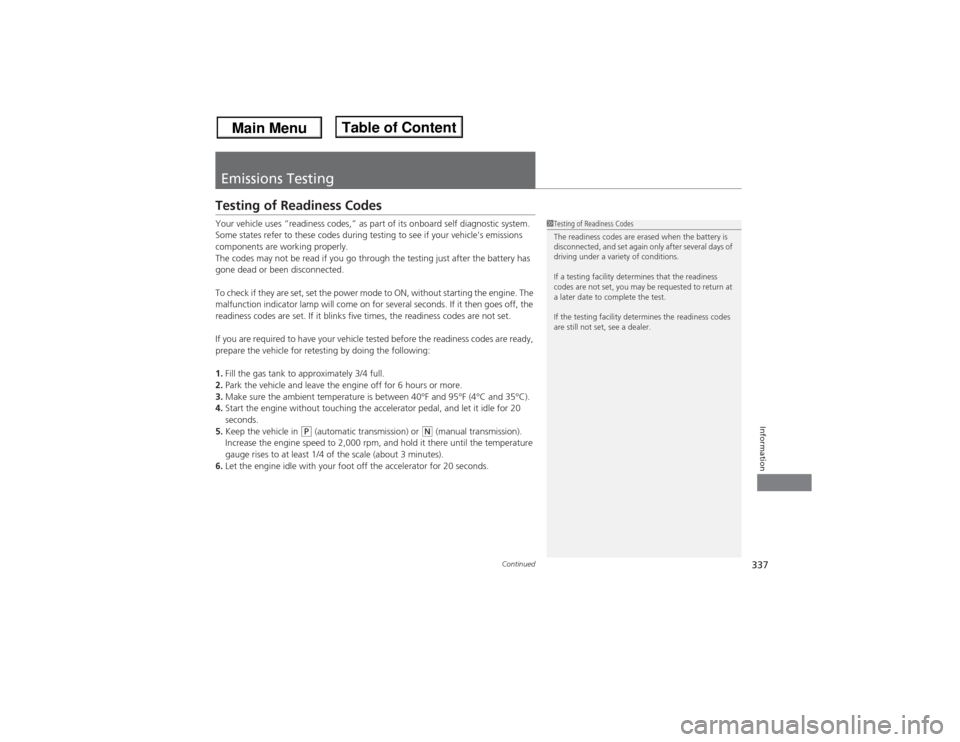
337
Continued
Information
Emissions TestingTesting of Readiness CodesYour vehicle uses “readiness codes,” as part of its onboard self diagnostic system.
Some states refer to these codes during testing to see if your vehicle's emissions
components are working properly.
The codes may not be read if you go through the testing just after the battery has
gone dead or been disconnected.
To check if they are set, set the power mode to ON, without starting the engine. The
malfunction indicator lamp will come on for several seconds. If it then goes off, the
readiness codes are set. If it blinks five times, the readiness codes are not set.
If you are required to have your vehicle tested before the readiness codes are ready,
prepare the vehicle for retesting by doing the following:
1.Fill the gas tank to approximately 3/4 full.
2.Park the vehicle and leave the engine off for 6 hours or more.
3.Make sure the ambient temperature is between 40°F and 95°F (4°C and 35°C).
4.Start the engine without touching the accelerator pedal, and let it idle for 20
seconds.
5.Keep the vehicle in
(P (automatic transmission) or
(N (manual transmission).
Increase the engine speed to 2,000 rpm, and hold it there until the temperature
gauge rises to at least 1/4 of the scale (about 3 minutes).
6.Let the engine idle with your foot off the accelerator for 20 seconds.
1Testing of Readiness Codes
The readiness codes are erased when the battery is
disconnected, and set again only after several days of
driving under a variety of conditions.
If a testing facility determines that the readiness
codes are not set, you may be requested to return at
a later date to complete the test.
If the testing facility determines the readiness codes
are still not set, see a dealer.
Page 339 of 351
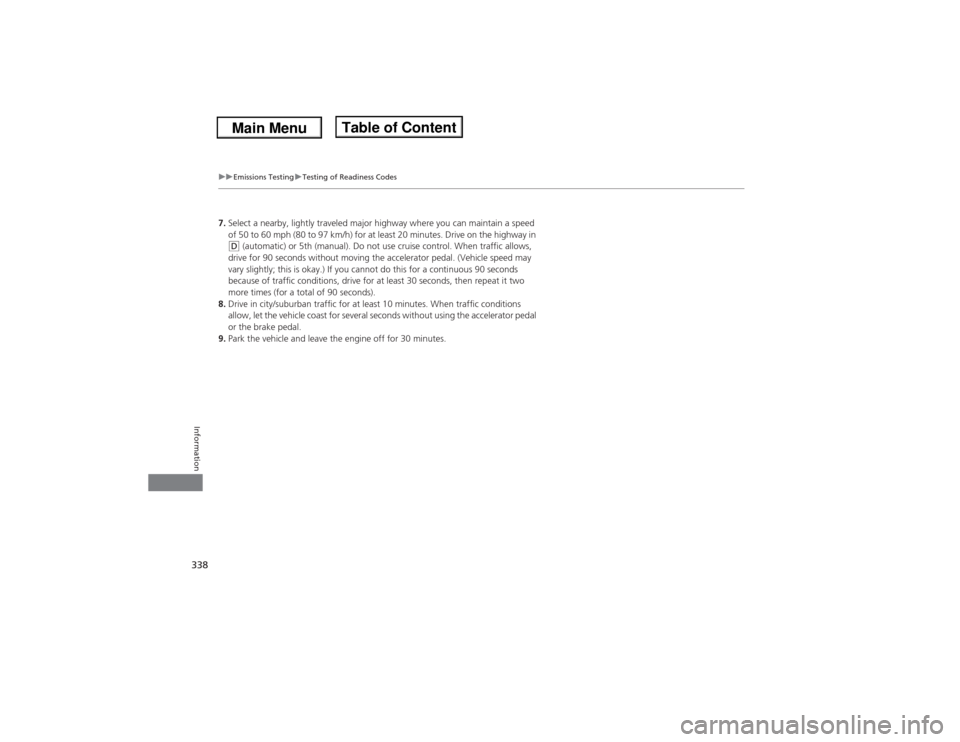
338
uuEmissions TestinguTesting of Readiness Codes
Information
7.Select a nearby, lightly traveled major highway where you can maintain a speed
of 50 to 60 mph (80 to 97 km/h) for at least 20 minutes. Drive on the highway in (D (automatic) or 5th (manual). Do not use cruise control. When traffic allows,
drive for 90 seconds without moving the accelerator pedal. (Vehicle speed may
vary slightly; this is okay.) If you cannot do this for a continuous 90 seconds
because of traffic conditions, drive for at least 30 seconds, then repeat it two
more times (for a total of 90 seconds).
8.Drive in city/suburban traffic for at least 10 minutes. When traffic conditions
allow, let the vehicle coast for several seconds without using the accelerator pedal
or the brake pedal.
9.Park the vehicle and leave the engine off for 30 minutes.
Page 340 of 351
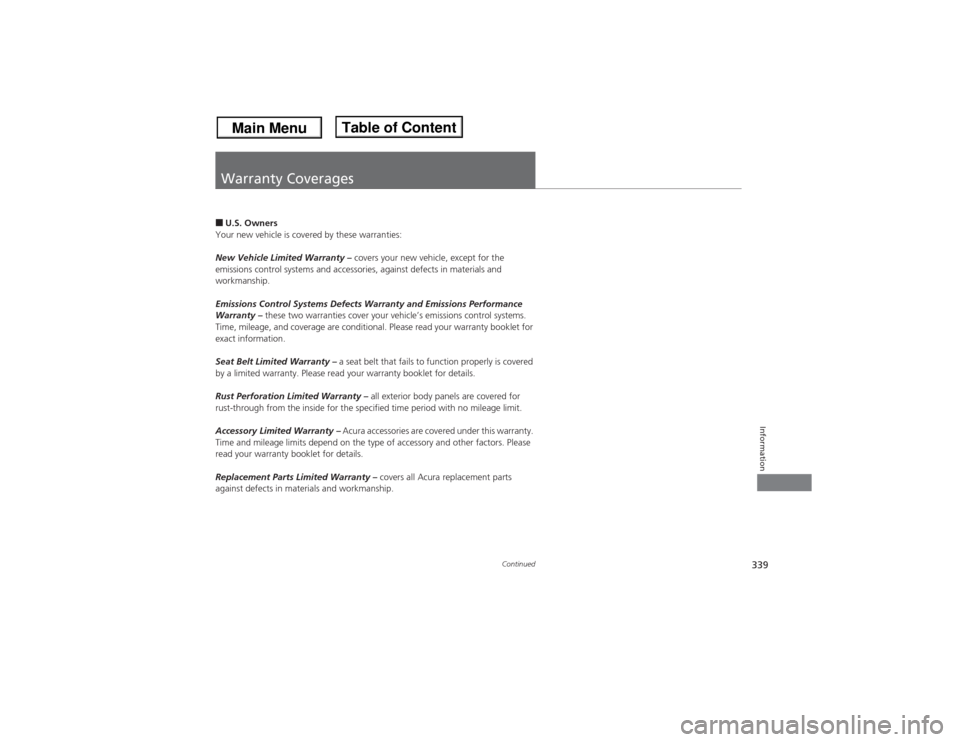
339
Continued
Information
Warranty Coverages■U.S. Owners
Your new vehicle is covered by these warranties:
New Vehicle Limited Warranty – covers your new vehicle, except for the
emissions control systems and accessories, against defects in materials and
workmanship.
Emissions Control Systems Defects Warranty and Emissions Performance
Warranty – these two warranties cover your vehicle’s emissions control systems.
Time, mileage, and coverage are conditional. Please read your warranty booklet for
exact information.
Seat Belt Limited Warranty – a seat belt that fails to function properly is covered
by a limited warranty. Please read your warranty booklet for details.
Rust Perforation Limited Warranty – all exterior body panels are covered for
rust-through from the inside for the specified time period with no mileage limit.
Accessory Limited Warranty – Acura accessories are covered under this warranty.
Time and mileage limits depend on the type of accessory and other factors. Please
read your warranty booklet for details.
Replacement Parts Limited Warranty – covers all Acura replacement parts
against defects in materials and workmanship.